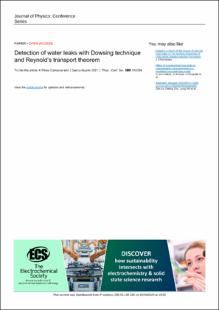Mostrar el registro sencillo del ítem
Detection of water leaks with Dowsing technique and Reynold's transport theorem
| dc.contributor.author | García Guarín, J | |
| dc.contributor.author | Pérez Carrascal, K | |
| dc.date.accessioned | 2024-04-26T15:44:07Z | |
| dc.date.available | 2024-04-26T15:44:07Z | |
| dc.date.issued | 2021-05-22 | |
| dc.identifier.uri | https://repositorio.ufps.edu.co/handle/ufps/7062 | |
| dc.description.abstract | Zahorí techniques are traditionally used to detect water currents in land for subsequent extraction. On the other hand, water leaks represent economic losses in factories and residences. It is enough to survey a city and determine the exaggerated number of residential leaks. Once the leak appears, a corrective action must be taken, this action is founded in itself and in the problems derived from this failure; and it is that knowing the exact location of a leak is risky if strictly collateral damage appears in the property. This research proposes to complement two different techniques, the first detects the presence of water based on the Dowsing search, and the second uses the Reynolds Transport Theorem to detect the leak relying on numerical methods and computational simulation. The Dowsing search proved to be reliable to detect the presence of water, the Reynolds Transport Theorem, yields the location of the leak with an average relative error of 10.6727% and the computational simulation corroborates Darcy's Law. Therefore, the method proposed in this investigation is sufficient for the corrective management of leaks. | eng |
| dc.format.extent | 8 Páginas | spa |
| dc.format.mimetype | application/pdf | spa |
| dc.language.iso | eng | spa |
| dc.publisher | Journal of Physics: Conference Series | spa |
| dc.relation.ispartof | Journal of Physics: Conference Series 1981 (2021) 012004doi:10.1088/1742-6596/1981/1/012004 | |
| dc.rights | Content from this work may be used under the terms of theCreative Commons Attribution 3.0 licence | eng |
| dc.rights.uri | https://creativecommons.org/licenses/by/4.0/ | spa |
| dc.source | https://iopscience.iop.org/article/10.1088/1742-6596/1981/1/012004 | spa |
| dc.title | Detection of water leaks with Dowsing technique and Reynold's transport theorem | eng |
| dc.type | Artículo de revista | spa |
| dcterms.references | Puust R, Kapelan Z, Savic D A and Koppel T 2010 A review of methods for leakage management in pipe networks Urban Water J. 7 25 | spa |
| dcterms.references | Colombo A F and Karney B W 2002 Energy and costs of leaky pipes: toward comprehensive picture J. Water Resour. Plan. Manag. 128 441 | spa |
| dcterms.references | Hunaidi O, Wang A, Bracken M, Gambino T and Fricke C 2004 Acoustic methods for locating leaks in municipal water pipe networks International Conference on Water Demand Management (Jordan) (Instute for Research in Construction) 1 | spa |
| dcterms.references | Moyer E E, Male J W, Moore I C and Hock J G 1983 The economics off leak detection and repair-a case study J. Am. Water Works Assoc. 75 28 | spa |
| dcterms.references | Cascetta F and Vigo P 1992 Location and assessment of water leakage Meas. Control 25 269 | spa |
| dcterms.references | Hessel G, Schmitt W, Van Der Vorst K and Weiss F P 1999 A neural network approach for acoustic leak monitoring in the VVER-440 pressure vessel head Prog. Nucl. Energy 34 173 | spa |
| dcterms.references | O'Brien E, Murray T and McDonald A 2003 PEDS 2003 Fifth International Conference on Power Electronics and Drive Systems (Singapure: IEEE) Detecting leaks from water pipes at a test facility using ground-penetrating radar 395 | spa |
| dcterms.references | Puust R, Kapelan Z, Savic D and Koppel T 2007 Probabilistic Leak Detection in Pipe Networks Using the SCEM-UA Algorithm (Tallinn: Tallinn University of Technology) | spa |
| dcterms.references | Durand J-Y 2003 Hydrogeology and water-dowsing: countercurrents and confluences Jean-Yves Int. Water Hist. Assoc. 3 1 | spa |
| dcterms.references | Lawson T J and Crane L L 2014 Dowsing rods designed to sharpen critical thinking and understanding of ideomotor action Teach. Psychol. 41 52 | spa |
| dcterms.references | Jakobsen H A 2014 Chemical Reactor Modeling: Multiphase Reactive Flows (Switzerland: Springer International Publishing) | spa |
| dcterms.references | Greenshields C 2020 User Guide (France: OpenFOAM Foundation) | spa |
| dcterms.references | Arévalo Silva M, Cárdenas Chinchilla A, Fossi F J and Garcia-Guarin J 2019 Numerical modeling of a liquid-gas interface flow in a channel J. Phys. Conf. Ser. 1257 1 | spa |
| dc.identifier.doi | 10.1088/1742-6596/1981/1/012004 | |
| dc.relation.citationedition | Vol.1981 No. (2021) | spa |
| dc.relation.citationendpage | 8 | spa |
| dc.relation.citationissue | (2021) | spa |
| dc.relation.citationstartpage | 1 | spa |
| dc.relation.citationvolume | 1981 | spa |
| dc.relation.cites | K Pérez-Carrascal and J García-Guarín 2021 J. Phys.: Conf. Ser. 1981 012004 | |
| dc.rights.accessrights | info:eu-repo/semantics/openAccess | spa |
| dc.rights.creativecommons | Atribución 4.0 Internacional (CC BY 4.0) | spa |
| dc.type.coar | http://purl.org/coar/resource_type/c_6501 | spa |
| dc.type.content | Text | spa |
| dc.type.driver | info:eu-repo/semantics/article | spa |
| dc.type.redcol | http://purl.org/redcol/resource_type/ART | spa |
| oaire.accessrights | http://purl.org/coar/access_right/c_abf2 | spa |
| oaire.version | http://purl.org/coar/version/c_970fb48d4fbd8a85 | spa |
| dc.type.version | info:eu-repo/semantics/publishedVersion | spa |
Ficheros en el ítem
Este ítem aparece en la(s) siguiente(s) colección(ones)
-
EULER [81]











